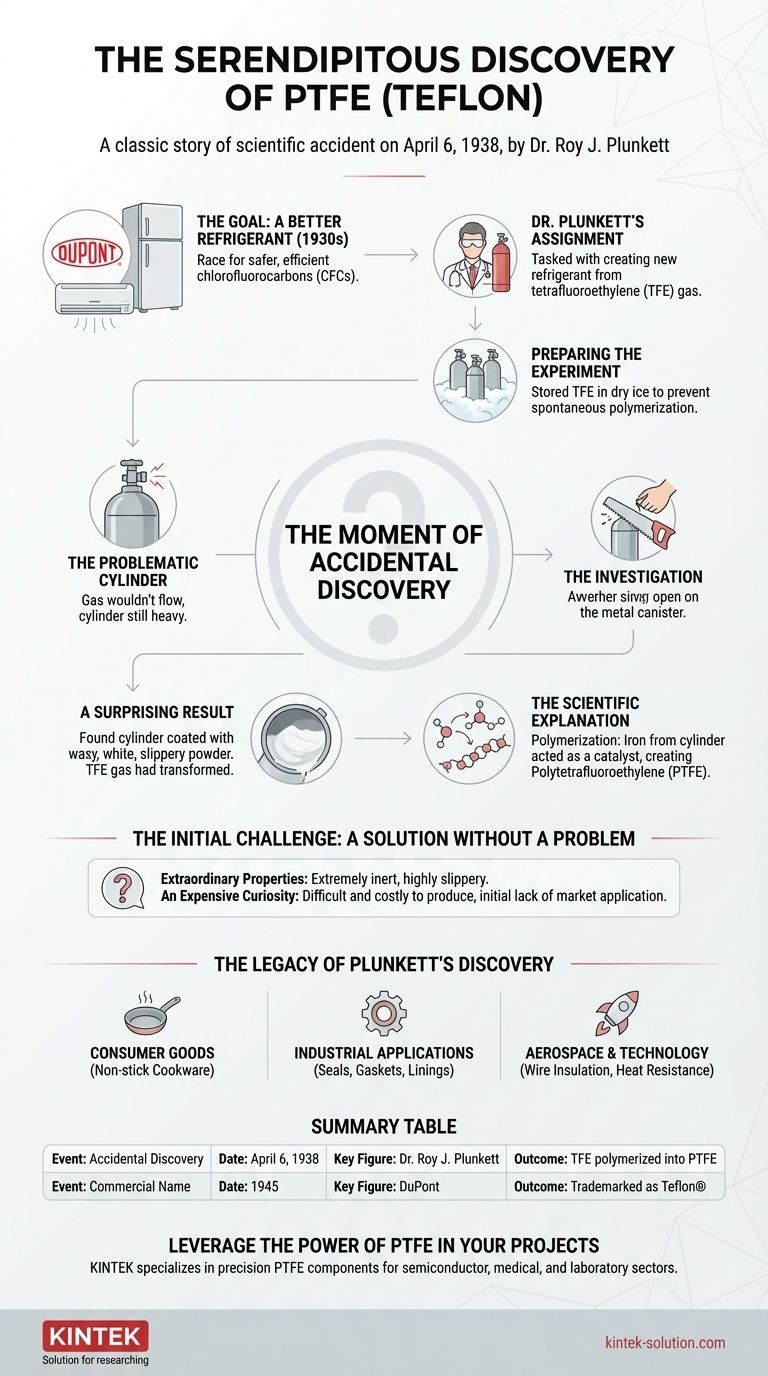In short, Polytetrafluoroethylene (PTFE) was discovered entirely by accident. On April 6, 1938, a chemist named Dr. Roy J. Plunkett was working at a DuPont facility in New Jersey, attempting to create a new, non-toxic refrigerant gas. Instead, one of his experimental gas cylinders produced a strange, waxy white solid with incredibly unique properties, leading to the creation of a revolutionary new material.
The discovery of PTFE is a classic story of scientific serendipity. A failed experiment to create a new refrigerant inadvertently revealed a novel polymer with properties so unusual that its initial purpose was a complete mystery.

The Goal: A Better Refrigerant
In the 1930s, chemical companies were in a race to develop safer and more efficient cooling agents, known as chlorofluorocarbons (CFCs), for refrigerators and air conditioners.
Dr. Plunkett's Assignment
Dr. Roy J. Plunkett, a young chemist at DuPont, was tasked with creating a new refrigerant from a gas called tetrafluoroethylene (TFE). His plan was to react the TFE with other chemicals to produce the desired compound.
Preparing the Experiment
To begin his work, Plunkett and his assistant stored cylinders of the TFE gas in dry ice. This was done to freeze the gas and prevent it from spontaneously and explosively polymerizing—a known risk with TFE.
The Moment of Accidental Discovery
The actual discovery occurred when an experiment didn't go according to plan. What began as a routine procedure quickly turned into a scientific puzzle.
The Problematic Cylinder
When Plunkett prepared to use one of the TFE cylinders, he found that the gas would not flow out, even though the valve was open. Based on the cylinder's weight, he knew it was still full of material.
The Investigation
Intrigued, Plunkett refused to discard the cylinder. Instead, he made the fateful decision to saw the metal canister open to investigate what had happened inside.
A Surprising Result
Inside, he did not find the gas he expected. The cylinder was coated with a waxy, white powder that was remarkably slippery. The TFE gas had transformed into a new solid substance.
The Scientific Explanation
Plunkett correctly deduced that the individual TFE gas molecules had joined together in a long chain, a process known as polymerization. The iron from the inner walls of the steel cylinder had acted as an unexpected catalyst, triggering the reaction under high pressure and creating the world's first sample of Polytetrafluoroethylene (PTFE).
The Initial Challenge: A Solution Without a Problem
Despite its incredible properties, PTFE was not an immediate commercial success. The material was a scientific curiosity with no obvious application.
Extraordinary Properties
Chemists at DuPont quickly determined that PTFE was unlike anything they had seen before. It was extremely inert, meaning it didn't react with virtually any other chemical, and it was one of the most slippery materials known to science.
An Expensive Curiosity
The process to create PTFE was difficult and expensive, and for years, DuPont struggled to find a market for it. This new "wonder material" was a solution in search of a problem. Its true potential would only be realized years later with the dawn of the atomic age, where its chemical resistance was needed for the Manhattan Project.
The Legacy of Plunkett's Discovery
The accidental discovery of PTFE ultimately changed multiple industries. The material was trademarked as Teflon in 1947, and its applications have become widespread.
- If your focus is on consumer goods: PTFE's most famous use is as the non-stick coating for cookware, which revolutionized home cooking.
- If your focus is on industrial applications: Its low friction and chemical resistance make it vital for seals, gaskets, and linings in manufacturing and chemical processing.
- If your focus is on aerospace and technology: It is used as a high-performance insulator for wiring and cables in computers and aircraft due to its excellent electrical properties and heat resistance.
Plunkett's story serves as a powerful reminder that some of the greatest scientific breakthroughs arise not from perfect execution, but from curiosity in the face of failure.
Summary Table:
| Event | Date | Key Figure | Outcome |
|---|---|---|---|
| Accidental Discovery | April 6, 1938 | Dr. Roy J. Plunkett | TFE gas polymerized into a waxy white solid (PTFE) |
| Initial Goal | 1930s | DuPont Chemists | Develop a new, safe chlorofluorocarbon (CFC) refrigerant |
| Catalyst | N/A | Iron from steel cylinder | Triggered polymerization under pressure |
| Commercial Name | 1945 | DuPont | Trademarked as Teflon® |
Leverage the Power of PTFE in Your Projects
Dr. Plunkett's accidental discovery paved the way for a material that is chemically inert, incredibly slippery, and thermally stable. KINTEK specializes in harnessing these unique properties for demanding applications.
We manufacture precision PTFE components—including seals, liners, and custom labware—for the semiconductor, medical, laboratory, and industrial sectors. Whether you need prototypes or high-volume production, our expertise ensures superior performance and reliability.
Ready to solve your unique material challenges? Contact KINTEK today to discuss your custom PTFE fabrication needs.
Visual Guide

Related Products
- Custom PTFE Measuring Cylinders for Advanced Scientific and Industrial Applications
- Custom PTFE Parts Manufacturer for Teflon Containers and Components
- Custom PTFE Parts Manufacturer for Teflon Parts and PTFE Tweezers
- PTFE Chemical Solvent Sampling Spoon
- Custom PTFE Volumetric Flasks for Advanced Scientific and Industrial Use
People Also Ask
- What material is the PTFE bottle made from? Discover the Benefits of 100% Virgin PTFE
- What are some exceptional properties of PTFE? Unlock Unmatched Performance in Extreme Environments
- What industrial applications does PTFE have? Unlock Performance in Extreme Environments
- What makes the PTFE bottle durable? Unmatched Chemical & Thermal Stability for Demanding Applications
- What are the unique properties of PTFE that make it commercially valuable? Unlock Unmatched Performance



















